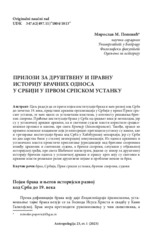Приказ основних података о документу
Прилози за друштвену и правну историју брачних односа у Србији у Првом српском устанку
Contributions to the social and legal history of marriage relations in Serbia during the first Serbian uprising
| dc.creator | Поповић, Мирослав | |
| dc.date.accessioned | 2023-08-25T11:36:29Z | |
| dc.date.available | 2023-08-25T11:36:29Z | |
| dc.date.issued | 2023 | |
| dc.identifier.issn | 1452-7243 | |
| dc.identifier.uri | http://reff.f.bg.ac.rs/handle/123456789/4739 | |
| dc.description.abstract | Циљ рада је да се прати појам институције брака и њен развој код Срба до почетка 19. века, представи црквена организација у Србији у време Првог српског устанка, те њен однос са устаничким властима, у контексту решавања брачних спорова. Праћење институције брака у Срба од средњег века је неопходна, јер су у устаничкој држави црквене, па и световне судске власти користиле средњовековне прописе и каноне, пре свега Крмчију (Законоправило). Такође, праксе из времена османске владавине која је непосредно претходила устанку су важне, као и третирање институције брака код Срба у Хабзбуршкој монархији, јер су Срби из два царства били у сталној непосредној комуникацији. Из односа црквених и устаничких власти проистиче преплитање јурисдикције над брачним споровима између црквених и световних судова, а брачни спорови, сачувани у објављеној историјској грађи, пре свега Шабачког магистрата, једини су извор за друштвену историју брачних односа у устаничкој држави и праксу кроз коју су световне и црквене власти решавале разне друштвене појаве и проблеме везане за брак. | sr |
| dc.description.abstract | The aim of the paper is to, after the introductory part, in which the notion of the institution of marriage and its development among Serbs until the beginning of the 19th century are followed, in the second part to present the church organization in Serbia at the time of the First Serbian Uprising, and its relationship with the insurgent authorities. Following the institution of marriage in Serbs since the Middle Ages is necessary, because in the Uprising state, the church authorities used medieval regulations and canons, primarily the Krmčija (Zakonopravilo). Also, practices from the time of Ottoman rule that immediately preceded the uprising are important, as well as the treatment of the institution of marriage among Serbs in the Habsburg Monarchy, because Serbs from the two empires were in constant direct communication. The relationship between the church and the insurgent authorities results in the intertwining of jurisdiction over marital disputes between the church and secular courts, and the marital disputes, preserved in the published historical sources, primarily of the Šabac magistrate, are the only source for the social history of marital relations in the insurgent state and the practice through which the secular and church authorities solved various social phenomena and problems related to marriage. | sr |
| dc.language.iso | sr | sr |
| dc.publisher | Institut za etnologiju i antropologiju Odeljenja za etnologiju i antropologiju Filozofskog fakulteta u Beogradu | sr |
| dc.publisher | Dosije studio, Beograd | sr |
| dc.rights | openAccess | sr |
| dc.rights.uri | https://creativecommons.org/licenses/by/4.0/ | |
| dc.source | Antropologija: časopis Instituta za etnologiju i antropologiju Filozofskog fakulteta u Beogradu | sr |
| dc.subject | брак | sr |
| dc.subject | Србија | sr |
| dc.subject | Први српски устанак | sr |
| dc.subject | брачни спорови, | sr |
| dc.subject | судови | sr |
| dc.subject | marriage | sr |
| dc.subject | Serbia | sr |
| dc.subject | First Serbian uprising | sr |
| dc.subject | marital disputes | sr |
| dc.subject | courts | sr |
| dc.title | Прилози за друштвену и правну историју брачних односа у Србији у Првом српском устанку | sr |
| dc.title | Contributions to the social and legal history of marriage relations in Serbia during the first Serbian uprising | sr |
| dc.type | article | sr |
| dc.rights.license | BY | sr |
| dc.citation.epage | 106 | |
| dc.citation.issue | 1 | |
| dc.citation.rank | M51~ | |
| dc.citation.spage | 91 | |
| dc.citation.volume | 23 | |
| dc.identifier.fulltext | http://reff.f.bg.ac.rs/bitstream/id/11622/Prilozi_za_drustvenu_i_pravnu_istoriju_b.pdf | |
| dc.identifier.rcub | https://hdl.handle.net/21.15107/rcub_reff_4739 | |
| dc.type.version | publishedVersion | sr |

